Fluid Mechanics Assignment: Analysis of Pipe Flow and Open Channels
VerifiedAdded on 2022/08/13
|7
|1296
|35
Homework Assignment
AI Summary
This document presents a comprehensive solution to a fluid mechanics assignment, addressing various aspects of fluid flow in both pipes and open channels. The solution begins with calculating pressure in a pipe and discussing frictional and boundary layer resistances. It then differentiates between laminar and turbulent flow, including the Reynolds number's significance. The assignment proceeds to solve problems using Manning's and Darcy-Weisbach equations to determine flow depth, head loss, and pipe diameter under different conditions. It also compares pipe flow and open channel flow, including the design of an open channel. Furthermore, the solution explores total head loss calculations, the necessity of pumps, and the impact of groundwater on retaining wall design, providing insights into structural considerations. The assignment concludes with discussions on preventing seepage in basements.
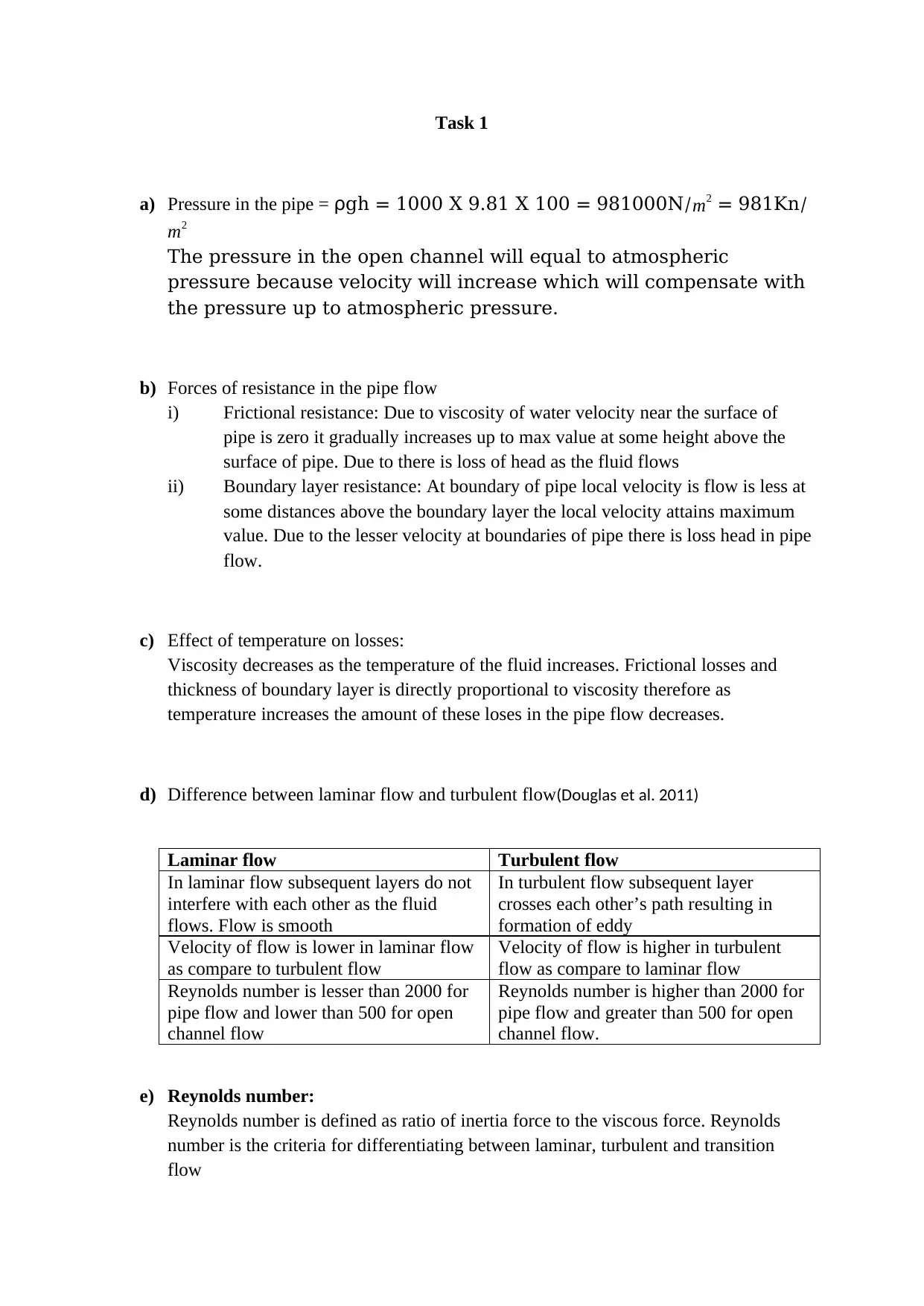
Task 1
a) Pressure in the pipe = gh = 1000 X 9.81 X 100 = 981000N/⍴ m2 = 981Kn/
m2
The pressure in the open channel will equal to atmospheric
pressure because velocity will increase which will compensate with
the pressure up to atmospheric pressure.
b) Forces of resistance in the pipe flow
i) Frictional resistance: Due to viscosity of water velocity near the surface of
pipe is zero it gradually increases up to max value at some height above the
surface of pipe. Due to there is loss of head as the fluid flows
ii) Boundary layer resistance: At boundary of pipe local velocity is flow is less at
some distances above the boundary layer the local velocity attains maximum
value. Due to the lesser velocity at boundaries of pipe there is loss head in pipe
flow.
c) Effect of temperature on losses:
Viscosity decreases as the temperature of the fluid increases. Frictional losses and
thickness of boundary layer is directly proportional to viscosity therefore as
temperature increases the amount of these loses in the pipe flow decreases.
d) Difference between laminar flow and turbulent flow(Douglas et al. 2011)
Laminar flow Turbulent flow
In laminar flow subsequent layers do not
interfere with each other as the fluid
flows. Flow is smooth
In turbulent flow subsequent layer
crosses each other’s path resulting in
formation of eddy
Velocity of flow is lower in laminar flow
as compare to turbulent flow
Velocity of flow is higher in turbulent
flow as compare to laminar flow
Reynolds number is lesser than 2000 for
pipe flow and lower than 500 for open
channel flow
Reynolds number is higher than 2000 for
pipe flow and greater than 500 for open
channel flow.
e) Reynolds number:
Reynolds number is defined as ratio of inertia force to the viscous force. Reynolds
number is the criteria for differentiating between laminar, turbulent and transition
flow
a) Pressure in the pipe = gh = 1000 X 9.81 X 100 = 981000N/⍴ m2 = 981Kn/
m2
The pressure in the open channel will equal to atmospheric
pressure because velocity will increase which will compensate with
the pressure up to atmospheric pressure.
b) Forces of resistance in the pipe flow
i) Frictional resistance: Due to viscosity of water velocity near the surface of
pipe is zero it gradually increases up to max value at some height above the
surface of pipe. Due to there is loss of head as the fluid flows
ii) Boundary layer resistance: At boundary of pipe local velocity is flow is less at
some distances above the boundary layer the local velocity attains maximum
value. Due to the lesser velocity at boundaries of pipe there is loss head in pipe
flow.
c) Effect of temperature on losses:
Viscosity decreases as the temperature of the fluid increases. Frictional losses and
thickness of boundary layer is directly proportional to viscosity therefore as
temperature increases the amount of these loses in the pipe flow decreases.
d) Difference between laminar flow and turbulent flow(Douglas et al. 2011)
Laminar flow Turbulent flow
In laminar flow subsequent layers do not
interfere with each other as the fluid
flows. Flow is smooth
In turbulent flow subsequent layer
crosses each other’s path resulting in
formation of eddy
Velocity of flow is lower in laminar flow
as compare to turbulent flow
Velocity of flow is higher in turbulent
flow as compare to laminar flow
Reynolds number is lesser than 2000 for
pipe flow and lower than 500 for open
channel flow
Reynolds number is higher than 2000 for
pipe flow and greater than 500 for open
channel flow.
e) Reynolds number:
Reynolds number is defined as ratio of inertia force to the viscous force. Reynolds
number is the criteria for differentiating between laminar, turbulent and transition
flow
Paraphrase This Document
Need a fresh take? Get an instant paraphrase of this document with our AI Paraphraser
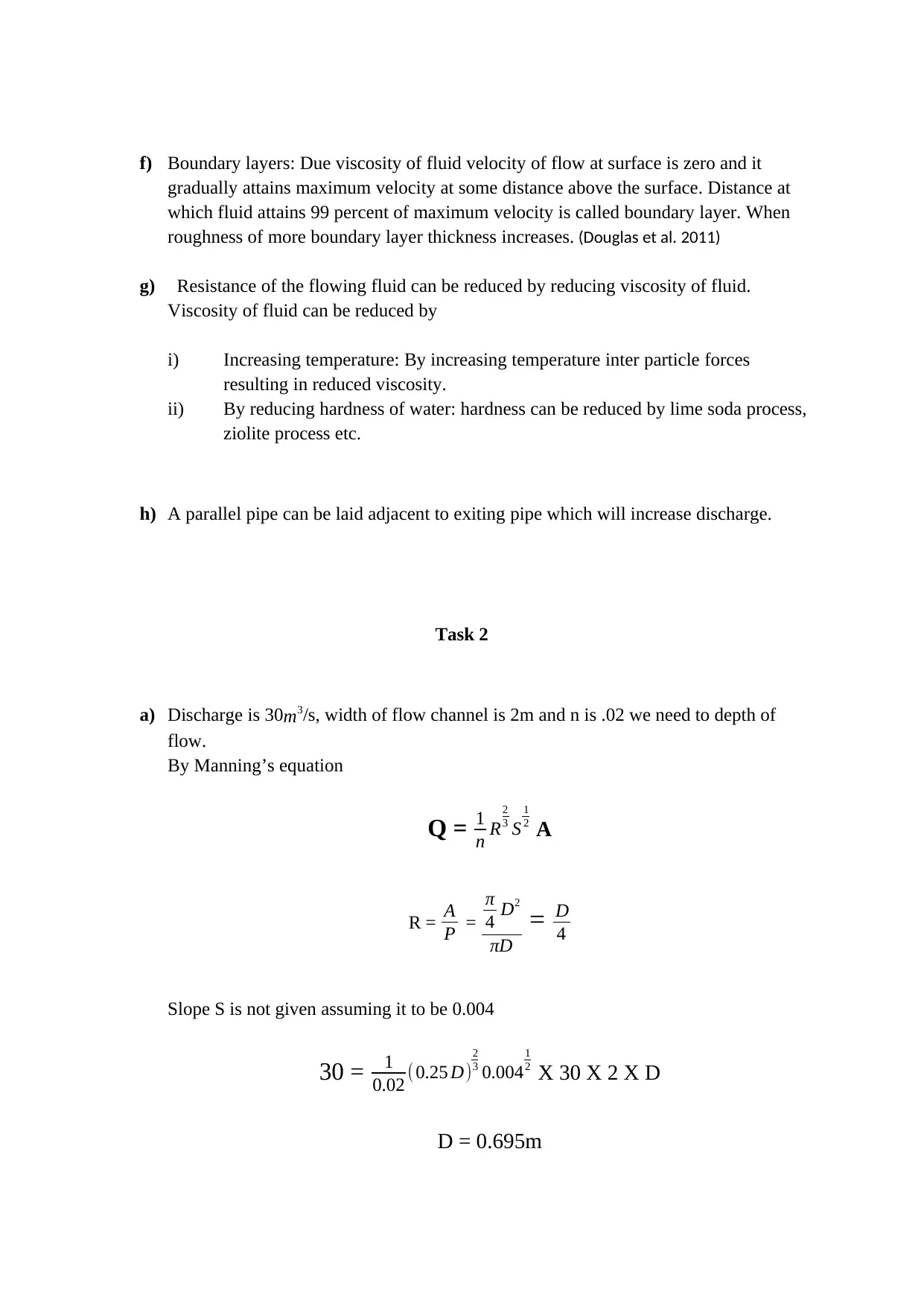
f) Boundary layers: Due viscosity of fluid velocity of flow at surface is zero and it
gradually attains maximum velocity at some distance above the surface. Distance at
which fluid attains 99 percent of maximum velocity is called boundary layer. When
roughness of more boundary layer thickness increases. (Douglas et al. 2011)
g) Resistance of the flowing fluid can be reduced by reducing viscosity of fluid.
Viscosity of fluid can be reduced by
i) Increasing temperature: By increasing temperature inter particle forces
resulting in reduced viscosity.
ii) By reducing hardness of water: hardness can be reduced by lime soda process,
ziolite process etc.
h) A parallel pipe can be laid adjacent to exiting pipe which will increase discharge.
Task 2
a) Discharge is 30m3/s, width of flow channel is 2m and n is .02 we need to depth of
flow.
By Manning’s equation
Q = 1
n R
2
3 S
1
2 A
R = A
P =
π
4 D2
πD
= D
4
Slope S is not given assuming it to be 0.004
30 = 1
0.02 ( 0.25 D)
2
3 0.004
1
2 X 30 X 2 X D
D = 0.695m
gradually attains maximum velocity at some distance above the surface. Distance at
which fluid attains 99 percent of maximum velocity is called boundary layer. When
roughness of more boundary layer thickness increases. (Douglas et al. 2011)
g) Resistance of the flowing fluid can be reduced by reducing viscosity of fluid.
Viscosity of fluid can be reduced by
i) Increasing temperature: By increasing temperature inter particle forces
resulting in reduced viscosity.
ii) By reducing hardness of water: hardness can be reduced by lime soda process,
ziolite process etc.
h) A parallel pipe can be laid adjacent to exiting pipe which will increase discharge.
Task 2
a) Discharge is 30m3/s, width of flow channel is 2m and n is .02 we need to depth of
flow.
By Manning’s equation
Q = 1
n R
2
3 S
1
2 A
R = A
P =
π
4 D2
πD
= D
4
Slope S is not given assuming it to be 0.004
30 = 1
0.02 ( 0.25 D)
2
3 0.004
1
2 X 30 X 2 X D
D = 0.695m
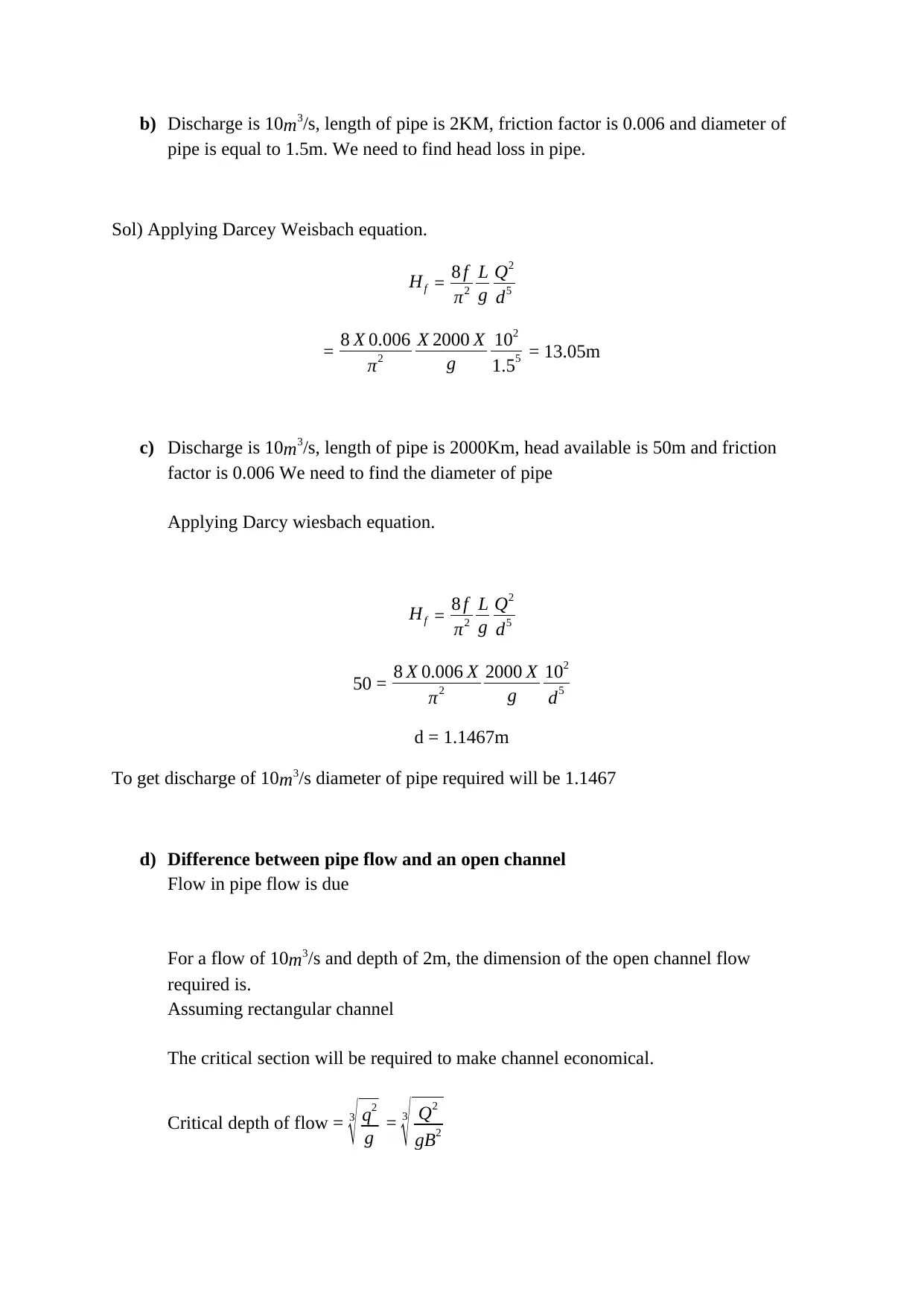
b) Discharge is 10m3/s, length of pipe is 2KM, friction factor is 0.006 and diameter of
pipe is equal to 1.5m. We need to find head loss in pipe.
Sol) Applying Darcey Weisbach equation.
Hf = 8 f
π2
L
g
Q2
d5
= 8 X 0.006
π2
X 2000 X
g
102
1.55 = 13.05m
c) Discharge is 10m3/s, length of pipe is 2000Km, head available is 50m and friction
factor is 0.006 We need to find the diameter of pipe
Applying Darcy wiesbach equation.
Hf = 8 f
π2
L
g
Q2
d5
50 = 8 X 0.006 X
π2
2000 X
g
102
d5
d = 1.1467m
To get discharge of 10 m3/s diameter of pipe required will be 1.1467
d) Difference between pipe flow and an open channel
Flow in pipe flow is due
For a flow of 10m3/s and depth of 2m, the dimension of the open channel flow
required is.
Assuming rectangular channel
The critical section will be required to make channel economical.
Critical depth of flow = 3
√ q2
g = 3
√ Q2
gB2
pipe is equal to 1.5m. We need to find head loss in pipe.
Sol) Applying Darcey Weisbach equation.
Hf = 8 f
π2
L
g
Q2
d5
= 8 X 0.006
π2
X 2000 X
g
102
1.55 = 13.05m
c) Discharge is 10m3/s, length of pipe is 2000Km, head available is 50m and friction
factor is 0.006 We need to find the diameter of pipe
Applying Darcy wiesbach equation.
Hf = 8 f
π2
L
g
Q2
d5
50 = 8 X 0.006 X
π2
2000 X
g
102
d5
d = 1.1467m
To get discharge of 10 m3/s diameter of pipe required will be 1.1467
d) Difference between pipe flow and an open channel
Flow in pipe flow is due
For a flow of 10m3/s and depth of 2m, the dimension of the open channel flow
required is.
Assuming rectangular channel
The critical section will be required to make channel economical.
Critical depth of flow = 3
√ q2
g = 3
√ Q2
gB2
⊘ This is a preview!⊘
Do you want full access?
Subscribe today to unlock all pages.

Trusted by 1+ million students worldwide
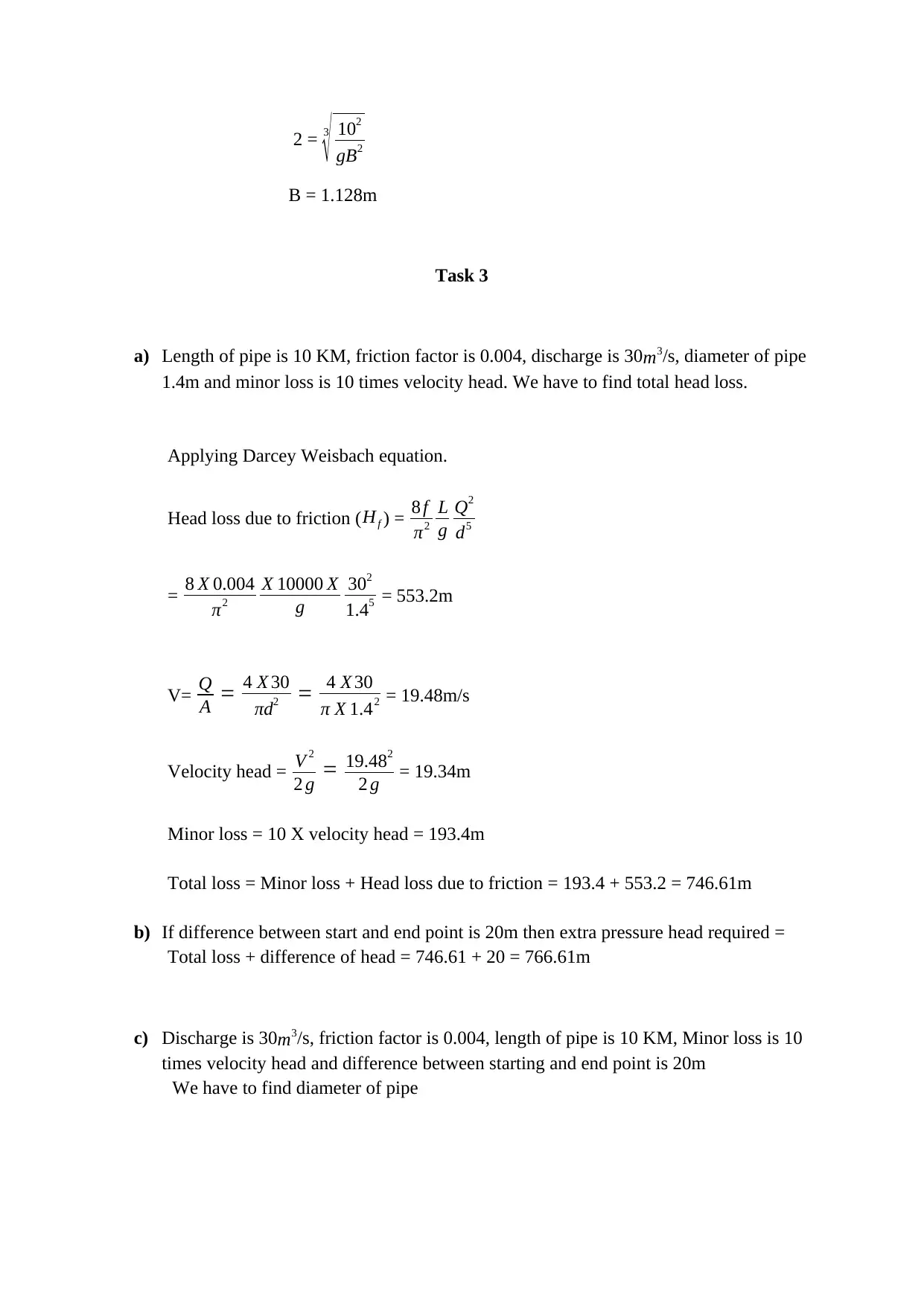
2 = 3
√ 102
gB2
B = 1.128m
Task 3
a) Length of pipe is 10 KM, friction factor is 0.004, discharge is 30 m3/s, diameter of pipe
1.4m and minor loss is 10 times velocity head. We have to find total head loss.
Applying Darcey Weisbach equation.
Head loss due to friction ( Hf ) = 8 f
π2
L
g
Q2
d5
= 8 X 0.004
π2
X 10000 X
g
302
1.45 = 553.2m
V= Q
A = 4 X 30
πd2 = 4 X 30
π X 1.42 = 19.48m/s
Velocity head = V 2
2 g = 19.482
2 g = 19.34m
Minor loss = 10 X velocity head = 193.4m
Total loss = Minor loss + Head loss due to friction = 193.4 + 553.2 = 746.61m
b) If difference between start and end point is 20m then extra pressure head required =
Total loss + difference of head = 746.61 + 20 = 766.61m
c) Discharge is 30m3/s, friction factor is 0.004, length of pipe is 10 KM, Minor loss is 10
times velocity head and difference between starting and end point is 20m
We have to find diameter of pipe
√ 102
gB2
B = 1.128m
Task 3
a) Length of pipe is 10 KM, friction factor is 0.004, discharge is 30 m3/s, diameter of pipe
1.4m and minor loss is 10 times velocity head. We have to find total head loss.
Applying Darcey Weisbach equation.
Head loss due to friction ( Hf ) = 8 f
π2
L
g
Q2
d5
= 8 X 0.004
π2
X 10000 X
g
302
1.45 = 553.2m
V= Q
A = 4 X 30
πd2 = 4 X 30
π X 1.42 = 19.48m/s
Velocity head = V 2
2 g = 19.482
2 g = 19.34m
Minor loss = 10 X velocity head = 193.4m
Total loss = Minor loss + Head loss due to friction = 193.4 + 553.2 = 746.61m
b) If difference between start and end point is 20m then extra pressure head required =
Total loss + difference of head = 746.61 + 20 = 766.61m
c) Discharge is 30m3/s, friction factor is 0.004, length of pipe is 10 KM, Minor loss is 10
times velocity head and difference between starting and end point is 20m
We have to find diameter of pipe
Paraphrase This Document
Need a fresh take? Get an instant paraphrase of this document with our AI Paraphraser
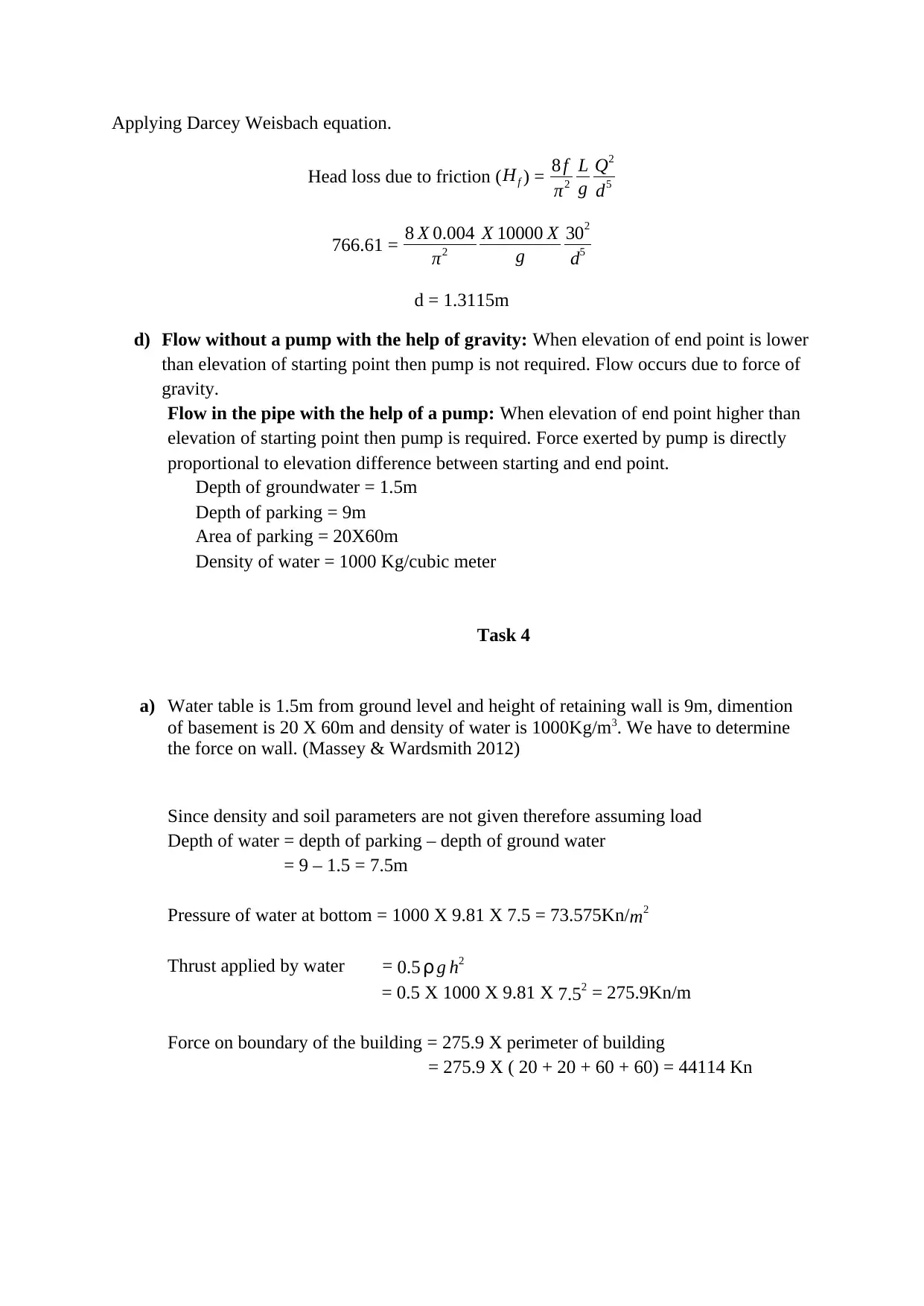
Applying Darcey Weisbach equation.
Head loss due to friction (Hf ) = 8 f
π2
L
g
Q2
d5
766.61 = 8 X 0.004
π2
X 10000 X
g
302
d5
d = 1.3115m
d) Flow without a pump with the help of gravity: When elevation of end point is lower
than elevation of starting point then pump is not required. Flow occurs due to force of
gravity.
Flow in the pipe with the help of a pump: When elevation of end point higher than
elevation of starting point then pump is required. Force exerted by pump is directly
proportional to elevation difference between starting and end point.
Depth of groundwater = 1.5m
Depth of parking = 9m
Area of parking = 20X60m
Density of water = 1000 Kg/cubic meter
Task 4
a) Water table is 1.5m from ground level and height of retaining wall is 9m, dimention
of basement is 20 X 60m and density of water is 1000Kg/m3. We have to determine
the force on wall. (Massey & Wardsmith 2012)
Since density and soil parameters are not given therefore assuming load
Depth of water = depth of parking – depth of ground water
= 9 – 1.5 = 7.5m
Pressure of water at bottom = 1000 X 9.81 X 7.5 = 73.575Kn/ m2
Thrust applied by water = 0.5 ⍴ g h2
= 0.5 X 1000 X 9.81 X 7.52 = 275.9Kn/m
Force on boundary of the building = 275.9 X perimeter of building
= 275.9 X ( 20 + 20 + 60 + 60) = 44114 Kn
Head loss due to friction (Hf ) = 8 f
π2
L
g
Q2
d5
766.61 = 8 X 0.004
π2
X 10000 X
g
302
d5
d = 1.3115m
d) Flow without a pump with the help of gravity: When elevation of end point is lower
than elevation of starting point then pump is not required. Flow occurs due to force of
gravity.
Flow in the pipe with the help of a pump: When elevation of end point higher than
elevation of starting point then pump is required. Force exerted by pump is directly
proportional to elevation difference between starting and end point.
Depth of groundwater = 1.5m
Depth of parking = 9m
Area of parking = 20X60m
Density of water = 1000 Kg/cubic meter
Task 4
a) Water table is 1.5m from ground level and height of retaining wall is 9m, dimention
of basement is 20 X 60m and density of water is 1000Kg/m3. We have to determine
the force on wall. (Massey & Wardsmith 2012)
Since density and soil parameters are not given therefore assuming load
Depth of water = depth of parking – depth of ground water
= 9 – 1.5 = 7.5m
Pressure of water at bottom = 1000 X 9.81 X 7.5 = 73.575Kn/ m2
Thrust applied by water = 0.5 ⍴ g h2
= 0.5 X 1000 X 9.81 X 7.52 = 275.9Kn/m
Force on boundary of the building = 275.9 X perimeter of building
= 275.9 X ( 20 + 20 + 60 + 60) = 44114 Kn
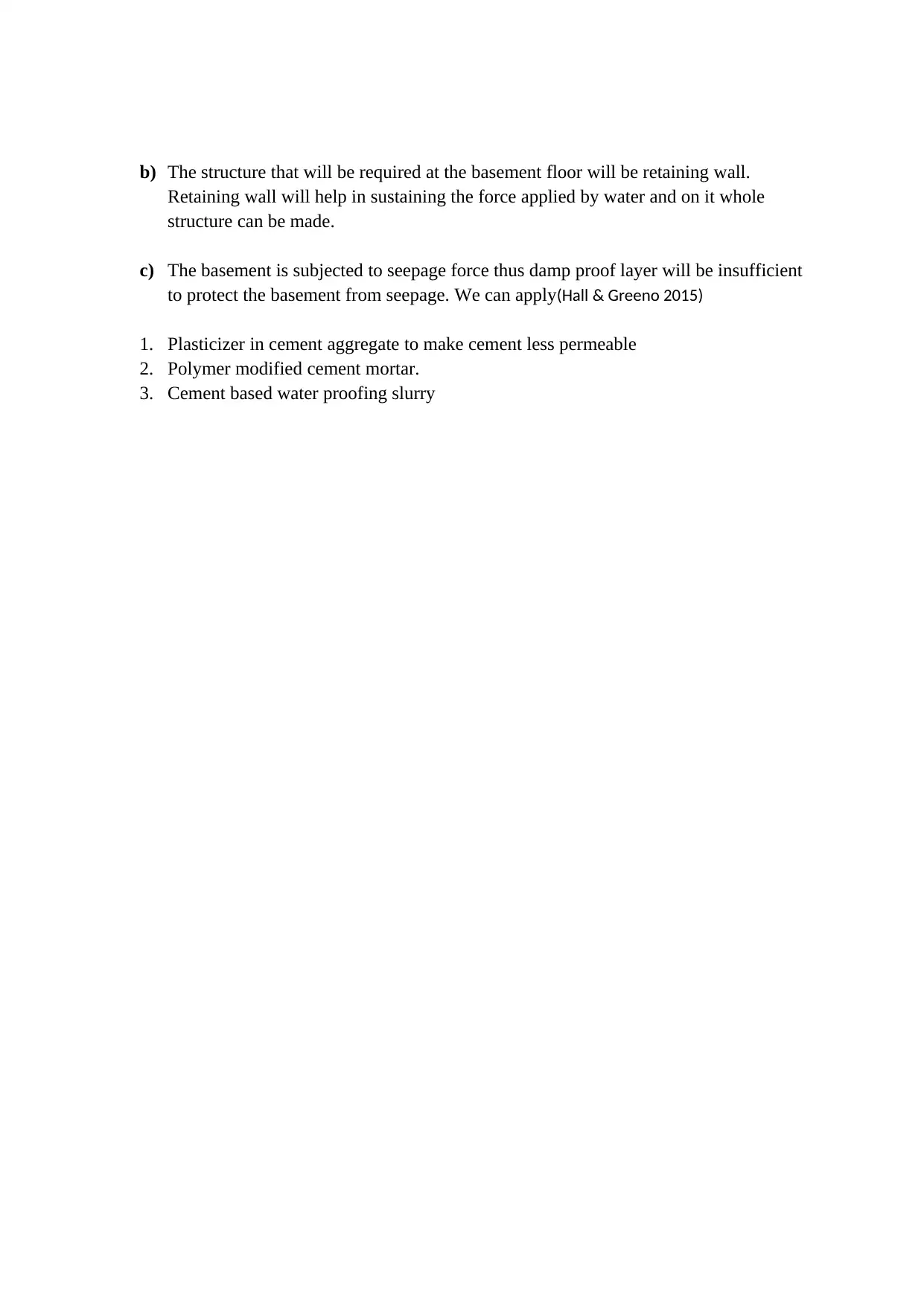
b) The structure that will be required at the basement floor will be retaining wall.
Retaining wall will help in sustaining the force applied by water and on it whole
structure can be made.
c) The basement is subjected to seepage force thus damp proof layer will be insufficient
to protect the basement from seepage. We can apply(Hall & Greeno 2015)
1. Plasticizer in cement aggregate to make cement less permeable
2. Polymer modified cement mortar.
3. Cement based water proofing slurry
Retaining wall will help in sustaining the force applied by water and on it whole
structure can be made.
c) The basement is subjected to seepage force thus damp proof layer will be insufficient
to protect the basement from seepage. We can apply(Hall & Greeno 2015)
1. Plasticizer in cement aggregate to make cement less permeable
2. Polymer modified cement mortar.
3. Cement based water proofing slurry
⊘ This is a preview!⊘
Do you want full access?
Subscribe today to unlock all pages.

Trusted by 1+ million students worldwide
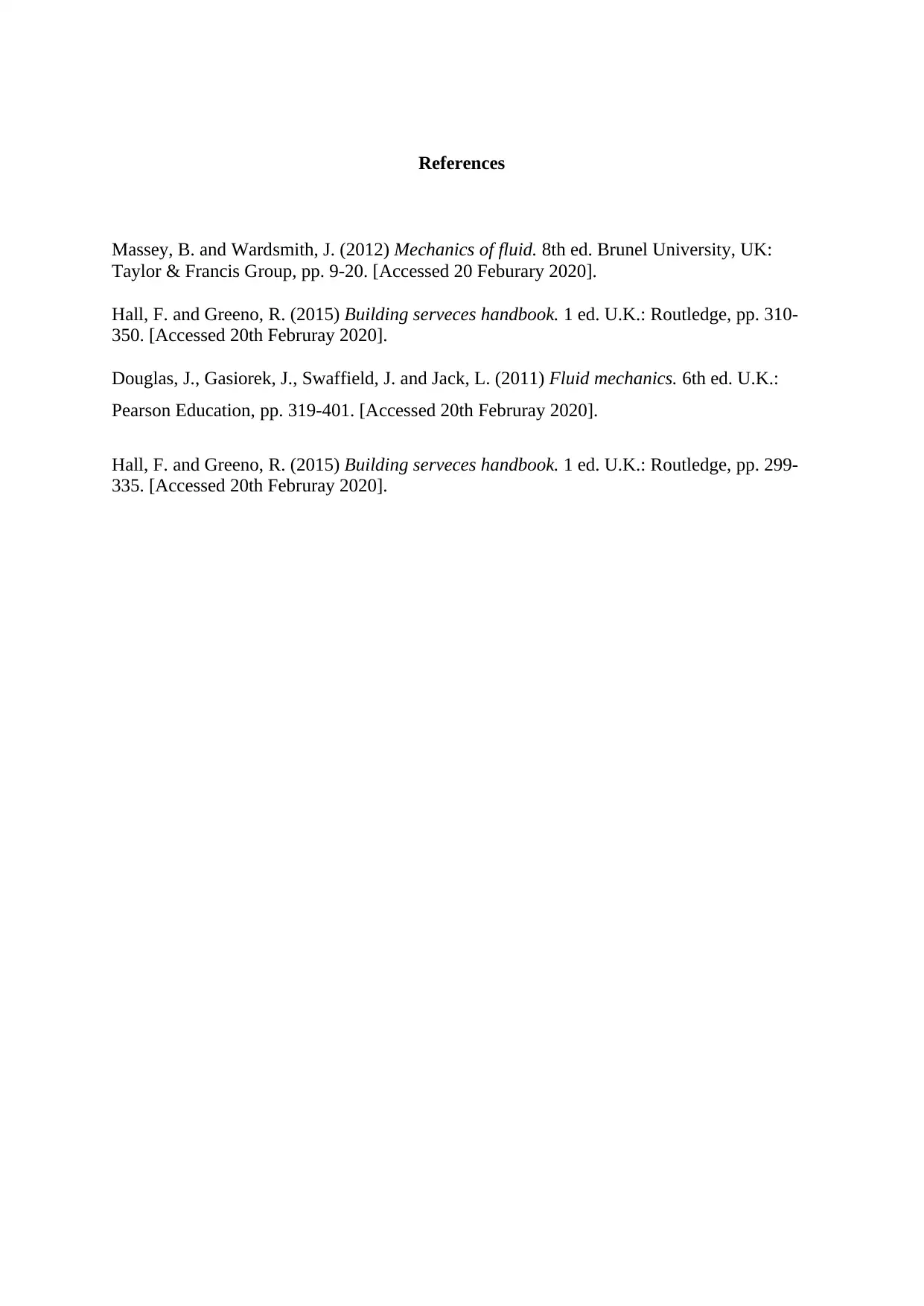
References
Massey, B. and Wardsmith, J. (2012) Mechanics of fluid. 8th ed. Brunel University, UK:
Taylor & Francis Group, pp. 9-20. [Accessed 20 Feburary 2020].
Hall, F. and Greeno, R. (2015) Building serveces handbook. 1 ed. U.K.: Routledge, pp. 310-
350. [Accessed 20th Februray 2020].
Douglas, J., Gasiorek, J., Swaffield, J. and Jack, L. (2011) Fluid mechanics. 6th ed. U.K.:
Pearson Education, pp. 319-401. [Accessed 20th Februray 2020].
Hall, F. and Greeno, R. (2015) Building serveces handbook. 1 ed. U.K.: Routledge, pp. 299-
335. [Accessed 20th Februray 2020].
Massey, B. and Wardsmith, J. (2012) Mechanics of fluid. 8th ed. Brunel University, UK:
Taylor & Francis Group, pp. 9-20. [Accessed 20 Feburary 2020].
Hall, F. and Greeno, R. (2015) Building serveces handbook. 1 ed. U.K.: Routledge, pp. 310-
350. [Accessed 20th Februray 2020].
Douglas, J., Gasiorek, J., Swaffield, J. and Jack, L. (2011) Fluid mechanics. 6th ed. U.K.:
Pearson Education, pp. 319-401. [Accessed 20th Februray 2020].
Hall, F. and Greeno, R. (2015) Building serveces handbook. 1 ed. U.K.: Routledge, pp. 299-
335. [Accessed 20th Februray 2020].
1 out of 7
Related Documents
Your All-in-One AI-Powered Toolkit for Academic Success.
+13062052269
info@desklib.com
Available 24*7 on WhatsApp / Email
![[object Object]](/_next/static/media/star-bottom.7253800d.svg)
Unlock your academic potential
Copyright © 2020–2025 A2Z Services. All Rights Reserved. Developed and managed by ZUCOL.





